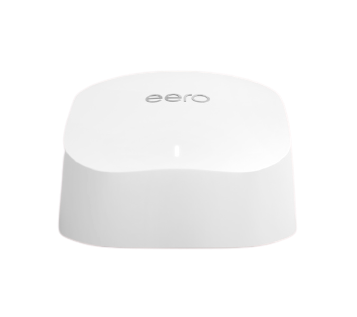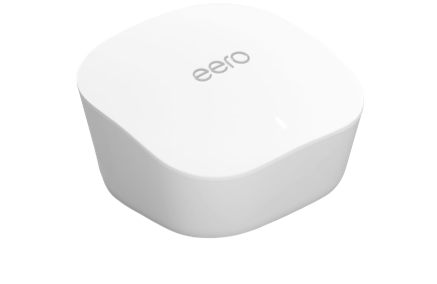Wi-Fi 6 vs. Wi-Fi 5: What are the major differences?

Eero 6

Wi-Fi 6 and the Eero 6 router offer greater speeds than similar Wi-Fi 5 routers thanks to 2x2 5GHz bands delivering 1201Mbps compared to Wi-Fi 5's 866.7Mbps. Wi-Fi 6 can also make use of technology like OFDMA, which allows better management of multiple connections to a single access point. If you want to get more speed out of your network with a compact router, Eero 6 is a great choice.
Eero 6
Wi-Fi 6 speed
Eero

For most people, Wi-Fi 5 isn't the main limiting factor in their internet speed. Eero's AC1300 speed can support internet connections of 350Mbps with ease. For most homes, this router will be more than fast enough for most activities including streaming 4K video. Eero's low price also makes it easy to make sure you have all the coverage you need when you are building your mesh.
Eero
Wi-Fi 5 savings
When it comes down to it, Wi-Fi 6's biggest advantage over Wi-Fi 5 is the raw speed. Eero suggests the original Eero router for internet speeds up to 350Mbps and for many people, that's more than enough. Still, Eero 6's upgrade to 900Mbps alone and 500Mbps in a mesh gives it quite a bit more life as internet connections continue to get faster and we ask more of our networks. Besides that, Eero 6 can handle connections from more devices thanks to OFDMA.
Wi-Fi 6 vs. Wi-Fi 5More efficient hardware
Whether it's Wi-Fi 6 (802.11ax), Wi-Fi 5 (802.11ac), or 802.11n, wireless routers can only access certain portions of the available wireless spectrum, which typically means 2.4GHz, 5.2GHz, and 5.8GHz in 40MHz and 80MHz chunks (though some high-end Wi-Fi 6 routers use 160MHz bands to take speeds even higher). This was technically possible with Wi-Fi 5, though it was never implemented in the U.S.
Wi-Fi 6 is also able to increase speeds within these restrictions thanks to further efficiencies, such as 1024-QAM compared to 256-QAM on Wi-Fi 5. Simply put, QAM is a modulation in the phase of the radio waves that allows for more simultaneous data streams. This is one of the main factors that has allowed Wi-Fi 6 devices to achieve approximately 40% more speed given the same wireless resources.
This uplift in speed has allowed the Eero 6 series to easily earn its place as one of the best Wi-Fi 6 mesh routers you can get.
| Header Cell - Column 0 | Eero 6 | Eero |
|---|---|---|
| Wireless standard | Wi-Fi 6 (802.11ax) Dual-band | Wi-Fi 5 (802.11ac) Dual-band |
| Wireless speed | AX1800 574Mbps + 1201Mbps | AC1300 400Mbps + 866.7Mbps |
| Features | MU-MIMO OFDMA WPA3 | MU-MIMO WPA3 |
| Coverage | 1,500 sq. ft. | 1,500 sq. ft. |
Moving forward, Wi-Fi 6 will also be able to work with your devices to improve battery life. Target wake time (TWT) allows devices to enter a sleep state when they don't need to transmit data. This can be great for improving battery life and power usage on always-connected devices that need to check-in online frequently. TWT hasn't been fully adopted yet but may come later as more routers look to get full Wi-Fi 6 certified.
Get the latest news from Android Central, your trusted companion in the world of Android
Wi-Fi 6 vs. Wi-Fi 5 How it works with your devices
If you've been researching Wi-Fi 6 routers, you may notice that most offer 1,201Mbps data speeds at 5GHz. It's possible to go faster than this, but this is as fast as most of your Wi-Fi 6-compatible devices, such as a Samsung Galaxy S20, will go. This is due to a 2x2 MU-MIMO setup at 80MHz. Higher-end routers can support faster speeds than this with wider 160MHz bands and 3x3 and 4x4 connections. This is one of the ways the Eero Pro 6 router can deliver gigabit speeds even when it's deployed in a mesh.
While some Wi-Fi 5 devices support speeds up to 1,300Mbps with 3x3 connections, most of them operated at 867Mbps. Similarly, some add-on PCI Express WiFi 6 cards will support AX3000 speeds (2,400Mbps + 600Mbps) thanks to 160MHz wide 5GHz bands.
Before you get too far into the weeds worrying about max speeds, remember that most people won't have an internet connection faster than 1Gbps and if they do, they won't be able to effectively use that much speed on a portable device. It also speaks to the efficiency of Wi-Fi 6 that even compact devices can get so close to the fastest speeds we saw on Wi-Fi 5.
Wi-Fi 6 vs. Wi-Fi 5 Managing more devices
A lot of development has been applied to consumer Wi-Fi 5 routers to improve performance even with a ton of devices. Beamforming, for example, can focus your wireless signal in the areas where it's needed most. That is also commonly used with mmWave 5G.
OFDMA is one of the more important advancements to come with Wi-Fi 6. Short for orthogonal frequency division multiple access, this allows the router to allocate portions of a larger channel to different devices as needed. The router can serve data to several devices at once rather than forming a single-file line. This can lead to a significant perceived improvement in uploads and downloads.
BSS Color, or base station color, can also be used by routers and devices to differentiate between different wireless access points. This allows a device to more efficiently recognize which wireless signal it should connect to, therefore reducing the impact of interference. This is great for those that live in a dense urban area with lots of access points.
Wi-Fi 6 vs. Wi-Fi 5 Backwards compatible
Of course, one of Wi-Fi 6's most important and easily overlooked features is that it works just as well with Wi-Fi 5 devices as a native Wi-Fi 5 router could. Not everybody is ready to upgrade all of their connected devices to make the most of a new router. There can even be some benefits to these devices since in a mesh, Wi-Fi 6 can improve the backhaul, and other devices that do support Wi-Fi 6 won't be fighting for speed on the older standard.
Wi-Fi 6 vs. Wi-Fi 6 Should you upgrade your wireless?

When it comes down to it, most of us can get by just fine on Wi-Fi 5 tech. Wi-Fi 5 routers have gotten very fast in their years on the market and if you have a fast Wi-Fi 5 router, the upgrade doesn't make a ton of sense. If you are ready to renovate your home network, it makes sense to go for Wi-Fi 6. Not only will a Wi-Fi 6 network be ready for your newest devices, but it will be able to stay fast even as you and your neighbors continue to use more data in the coming years.

When Samuel is not writing about networking or 5G at Android Central, he spends most of his time researching computer components and obsessing over what CPU goes into the ultimate Windows 98 computer. It's the Pentium 3.
